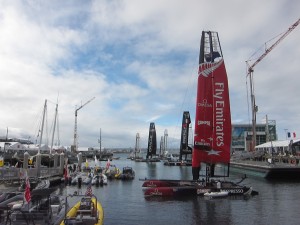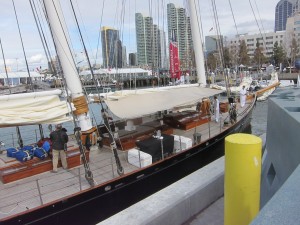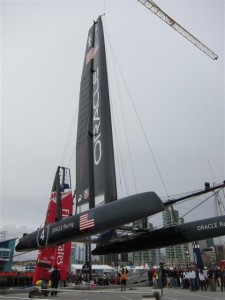We were invited to attend an event centered around America’s Cup Racing on Sunday, November 20th. It took place at the Navy Pier in downtown San Diego, in a tent that was set up next to the Midway Museum. In this photo, you can see the tents to the left on the Navy Pier. To the right is the cruise ship terminal. In the foreground of the cove between the piers is the New Zealand vessel. In the background you can clearly see a French and an American vessel. Farther in the background a few more vessels are not as clearly visible.
At 1000, the event started. A speaker explained the history of the event. The 1851 World Exposition was hosted by Queen Victoria in England. As part of the festivities, there was a sailing race around the Isle of Wight (a 53-nautical-mile course). 14 British ships and one American ship, named America, competed. America won. The prize was a silver trophy, now named after that ship, the America’s Cup. A few years later, the America crew donated the trophy into a trust to be used as a perpetual challenge trophy to promote friendly competition among nations.
Over the years, the rules changed and the racing event slowly evolved (there were even several court cases to help determine what were fair rules). In the last few years, the sport has changed dramatically. It used to be that, while all the boats had to fit certain parameters, each boat was different. Now all the boats are the same model of catamaran, so the competition is now truly about the skill of the crew versus the capacity of the various boat. Thanks to new technology, the cats can go three times faster than wind speed, topping out at over thirty knots!
The leadership have also made a concerted effort to make the race more of a spectator sport. Thanks to the ability to sail in light winds, now races are scheduled in light wind venues, like protected bays, where spectators can watch from shore. Actually, these new cats can’t really do ocean racing anymore anyway because they flip so easily. They can’t handle anything bigger than 6 foot seas. In the past, when the races were in the ocean, the only way to see the races was to jump on a spectator boat, which limited the exposure the races could get. Now the courses are a loop close to shore so many fans can watch live. Now that any average person can easily see the races, they are expected to become more popular with the general public and attract more big sponsors. The races last approximately 40 minutes, ideal for a one hour TV slot.
It was explained that the real America’s Cup competition would be held in 2013, but that there are still a series of preliminary races scheduled all over the world for this year and next year so that the various teams can get used to racing in the new standardized boats.
After the history lesson, we went into a simulator where they showed video footage of one of the cats sailing. It looked like a cold, windy day and the water was choppy, however, they were in a bay and had no swells. The cat made several dramatic flips, sending some crew overboard while others barely clung on. While they were adept and righting the boat and getting back on course, it looked like it took some serious physical strength. The audience was splashed with water to help make the simulator effect all the more real. We suppose they were trying to make the spectators understand how much strength, power and skill it took to crew the temperamental vessels, but we kept thinking that Kosmos would have barely rocked in those same sea conditions (with the stabilizers on, of course). Man, were we thankful for our solid boat and stabilizers after that demo!
Then we went to another simulator, but this one was like a video game. Selected people got to pretend they were racing a real America’s Cup boat. Eric was one of the lucky contestants. He took second place, missing the video game championship by a mere 8 seconds. Here he is being coached by one of the official Oracle team crew:
Then it was time for the “On the Water Experience.” We were loaded into a replica of the original America ship and taken out into San Diego Bay.
It was unusually cold and windy for San Diego, which made the racing more exciting (but cold for us spectators!). Winds were 14 – 19 knots, averaging 16 – 17. First we watched time trials, which wasn’t all that interesting. When the race finally started, we were ready for some action! The race certainly was eventful. When the boats were near us, we could clearly see the action, and a few times it looked like a few of the cats were on the verge of flipping, but they were righted in time. There was also a minor collision. Of course, when the boats weren’t on the other side of the bay, we could see little more than who was in the lead.
After the race was over, we were taken back to the tents. One of the two teams representing America (which, incidentally, was made up mostly of foreigners) came to speak to our group. It was exciting to have them in the room answering questions.
We also got to see a couple of the boats being taken out of the water and put on the hard near the tent. Here is a shot of one of the American boats about to be set down:
All in all, it was a fun day and an interesting experience.





